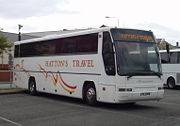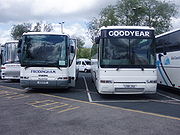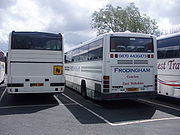
Plaxton Premiere
Encyclopedia

Coach (vehicle)
A coach is a large motor vehicle, a type of bus, used for conveying passengers on excursions and on longer distance express coach scheduled transport between cities - or even between countries...
bodywork
Coachwork
Coachwork is the body of a horse-drawn coach or carriage, a motor vehicle , a railroad car or railway carriage. Usually reserved for bodies built on a separate chassis, rather than being of unitary or monocoque construction...
built by Plaxton
Plaxton
Plaxton is a builder of bus and coach vehicle bodies based in Scarborough, England.-History:The Plaxton of today is the successor to a business founded in Scarborough in 1907 by Frederick William Plaxton.-Beginnings:...
.
The Premiere and Excalibur were introduced in 1991 as replacements for the Paramount
Plaxton Paramount
The Plaxton Paramount was a design of coach bodywork built by Plaxton. It first appeared at the 1982 British Motor Show and was built until 1991....
. The Premiere was the mainstream design, available in the same two heights as its predecessor (but expressed in centimetres, 320 and 350, rather than millimetres). The Excalibur was a premium specification coach, based on the Premiere 350 but with a more dramatically styled front end.
A taller export version of the Excalibur, built on Volvo B12 chassis, was briefly marketed by Volvo in France, and was named Prestige (a name which was subsequently re-used by Plaxton on the home market for a low-floor bus
Low-floor bus
A low-floor bus is a bus that has no steps between one or more entrances and part or all of the passenger cabin. Being low floor improves the accessibility of the bus for the public, particularly the elderly or infirm, or those with push chairs, and increasingly, those in wheelchairs.In the modern...
).
The Excalibur accounted for around 15% of production; the Premiere 350 was the most popular model taking about 45%; and the 3.2-metre Premiere 320 and Prima made up the remaining 40%.

Chassis
The Volvo B10MVolvo B10M
The Volvo B10M is a popular mid-engined bus and coach chassis built by Volvo between 1978 and 2001. It was built as the successor of the B58 and was equipped with a 9.6-litre horizontally-mounted Volvo THD100/THD101/THD102/THD103/THD104/DH10A diesel engine mounted under the floor, near the middle...
was by far the most popular chassis on which the range was built, accounting for nearly three quarters of the total (including over 90% of Excaliburs). The Dennis Javelin
Dennis Javelin
The Dennis Javelin is an underfloor-engined bus and coach chassis originally built by Dennis in the United Kingdom. It was unveiled in 1986 and acted more or less as a modern replacement for the discontinued Bedford Y-series...
chassis accounted for about 15% of output, with the remainder consisting of DAF SB3000, Volvo B7R
Volvo B7R
The Volvo B7R is a coach chassis available with a range of bodies. It is promoted as a rear engined lightweight coach chassis. It is primarily intended for tourist and long-distance duties...
, Volvo B12 and Scania K93 or K113.
Most of the Scanias were the low 320 model, and an early order from Shearings for thirty K93s accounted for a majority of them.
Over 97% of the bodies built were on 12m chassis.
Styling

The Premiere has an upright front end; the Excalibur's is heavily raked back, and a thicker pillar separates the door or cab from the adjacent window. An air-intake grille was incorporated into the bumper on early Volvo B10Ms, whereas a plain panel was used on other chassis types. Later B10Ms had an even simpler, single-barred opening, or a plain panel. Updates to the front end during 1993 were minor; subtle changes to the headlight area replaced the vertical inner edges with angled ones, and the removable front panel section was reduced in width.
The original design has two thin grooves running along the vehicle sides, level with the top and bottom of the headlights. This persisted after the 1993 update, but plain skirt panels were used on later built vehicles. Both designs of skirt panel curve neatly under at the bottom.
On early built vehicles, the high-mounted rear window curved up into the roof, with a horizontally grooved panel below it. Horizontal rear light clusters were fitted low down. The rear end underwent a major redesign in 1993 following complaints about leaks. The revised design had a flat rear window, separated from the roofline, and vertical rear light clusters mounted at the body corners.
Variants
- The Expressliner II was a variant of the Premiere 350 built to National Express specification on Volvo B10M chassis. The Expressliner name had previously been used on Paramount bodies built to a similar specification.
- The Interurban (or Premiere Interurban) was a variant of the Premiere 320 designed for medium distance interurban services. It was supplied to the Stagecoach group.
Replacement
The Premiere 350 and Excalibur were superseded by the ParagonPlaxton Paragon
The Plaxton Paragon and Plaxton Panther are closely related designs of coach bodywork built by Plaxton in Scarborough, England, since 1999, and still in production as of 2009....
and Panther respectively. The Prima, introduced as a variant of the low-height Premiere 320, was facelifted, with styling cues from the Paragon, to become the Plaxton Profile
Plaxton Profile
The Plaxton Profile is a coach built by Plaxton for the Volvo B7R and Dennis Javelin chassis. It is the smallest of Plaxton's full-sized coach range....
, which continues in production as of 2007.
Body numbering
Since the 1989 build season, Plaxton's body numbering system has used a letter to identify the body style. The following letters are used for the Premiere, Excalibur and Prima:- M Premiere 320 and Prima
- P Premiere 350
- S Excalibur
- T Prestige (high floor export coach)

